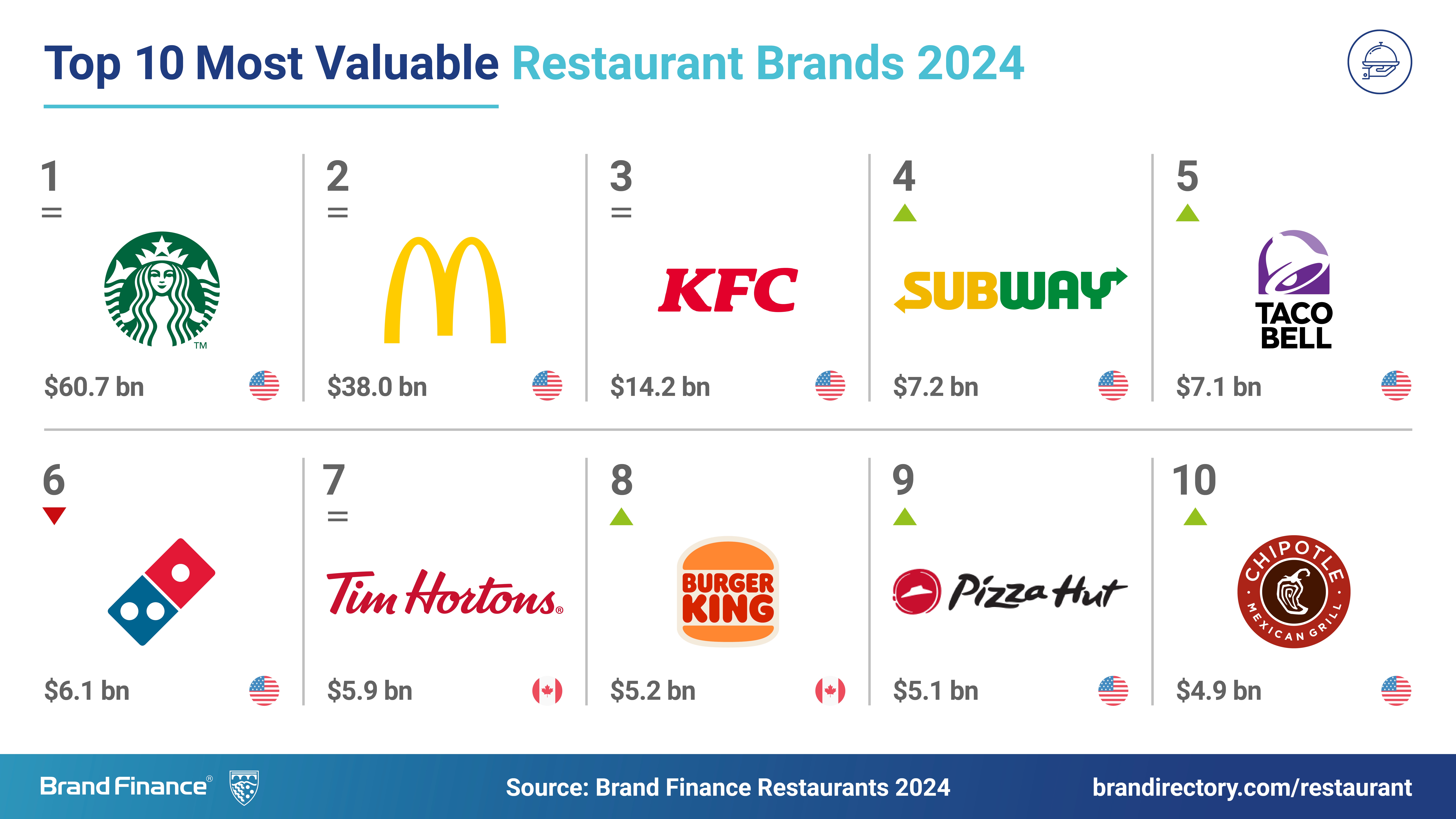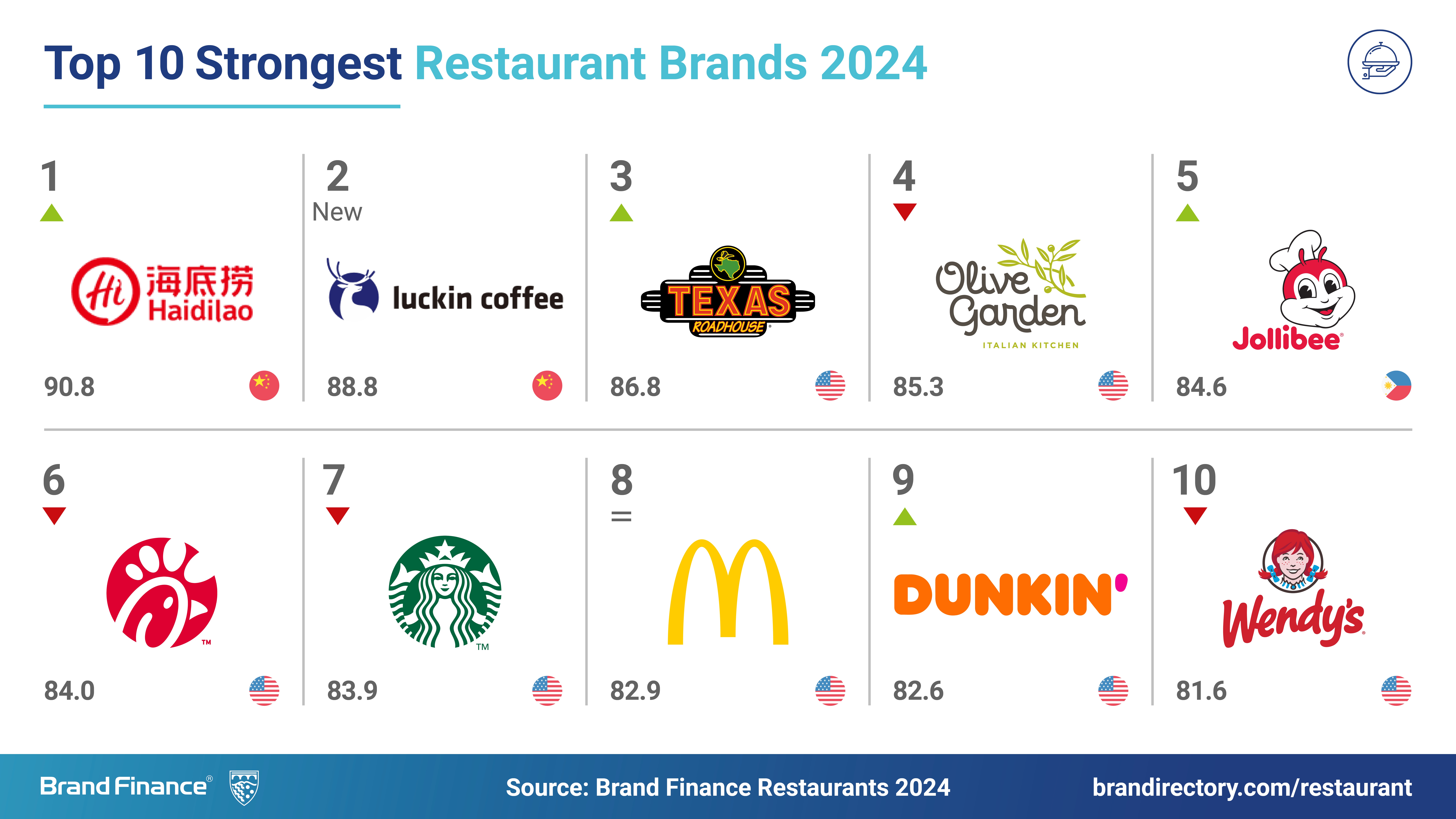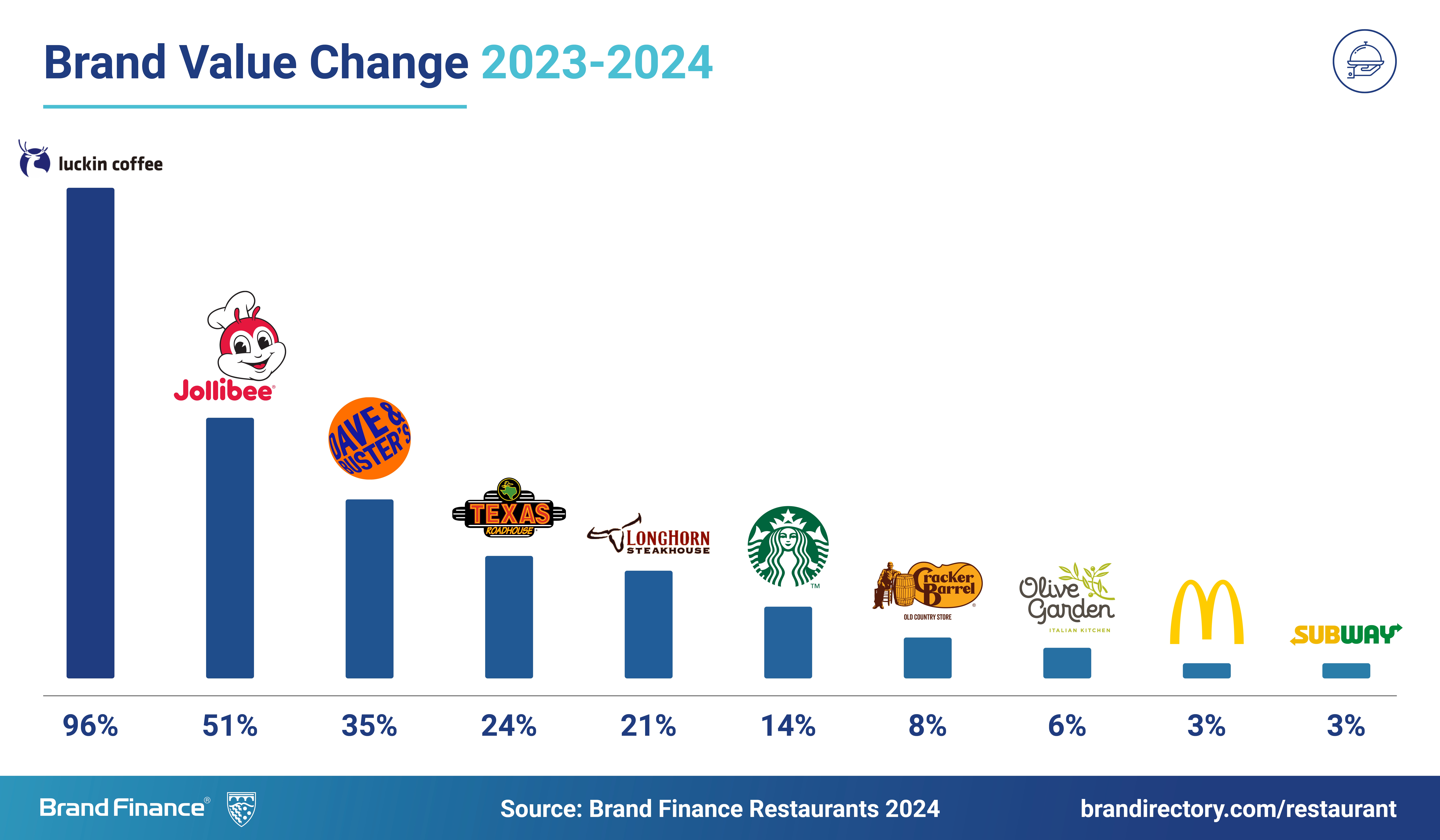American brands dominate ranking, fast food brand strength declines
View the full Brand Finance Restaurant 25 ranking
Starbucks is the world’s most valuable restaurant brand for the eighth consecutive year following a 14% brand value increase to USD60.7 billion, according to the new report from Brand Finance, the world’s leading brand valuation consultancy. This brand value increase aligns with the coffee chain’s reinvention plan, initiated in September 2022, which emphasises expansion, stronger employee support, and new, experiential store concepts. The increase is also bolstered by rising demand for its products, especially as people return to office routines, highlighting the brand’s enduring appeal in the evolving market.
American brands make up 19 out of the top 25 brands in the ranking and collectively account for 90% of the total brand value. McDonald's (brand value up 3% to USD38.0 billion) and KFC (brand value down 20% to USD14.2 billion) round off the top three, sitting in 2nd and 3rd place, respectively.
“The global restaurant industry is working to appeal to customers who generally have lower disposable income and may be grappling with higher living costs, and fast-food favourites are feeling the heat. Brand Finance research found thatrising menu prices are negatively impacting customer sentiment, resulting in a notable decline in brand strength among major players across the sector. However, those brands that have managed to uphold affordable pricing strategies have not only preserved but also grown their brand strength year-on-year, with notable examples including Jollibee, Dunkin', and Haidilao."
Alex Haigh, Managing Director, Brand Finance Asia
Luckin Coffee is the fastest-growing restaurant brand in the 2024 ranking, recording brand value growth of 96% to USD1.5 billion. This growth follows notable expansion, as Luckin Coffee opened1,485 new stores in China and entered the Singapore market last year. Setting itself apart with an innovative pricing approach, Luckin Coffee provides value for money, offering affordability and appealing options for consumers. According to Brand Finance’s research, both the reputation and familiarity of the brand have increased this year, contributing to an uptick in brand strength.
Jollibee is the second fastest-growing brand this year, with its brand value up 51% to USD2.3 billion, while maintaining a strong brand position in its domestic market. By partnering withbeloved Filipino cultural icon and lifestyle influencer Jolina Magdangal and her children its expanding range of children-centric offerings, Jollibee is poised to maintain its hometown popularity.
Brand Finance research reveals a dip in brand strength for major players including McDonald’s, KFC, Domino’s Pizza, Subway, and Burger King, with data indicating decreased scores for customer service, pricing perception, and how likely they are to recommend the restaurant to their friends and family.
Haidilao emerges as the world's strongest restaurant brand, with a Brand Strength Index (BSI) score of 90.8 out of 100 and one of a handful of brands across sectors to earn a rare AAA+ brand strength rating from Brand Finance. Haidilao’s brand strength is likely tied to its innovative approach to the customer experience. The restaurant offers free entertainment such as manicures and board games to keep customers busy and happy during wait times, a strategy that also earned Haidilao Brand Finance’s highest score for customer service in China, the restaurant’s home market.



Brand Finance is the world’s leading brand valuation consultancy. Bridging the gap between marketing and finance, Brand Finance evaluates the strength of brands and quantifies their financial value to help organisations make strategic decisions.
Headquartered in London, Brand Finance operates in over 25 countries. Every year, Brand Finance conducts more than 6,000 brand valuations, supported by original market research, and publishes over 100 reports which rank brands across all sectors and countries.
Brand Finance also operates the Global Brand Equity Monitor, conducting original market research annually on 6,000 brands, surveying more than 175,000 respondents across 41 countries and 31 industry sectors. By combining perceptual data from the Global Brand Equity Monitor with data from its valuation database — the largest brand value database in the world — Brand Finance equips ambitious brand leaders with the data, analytics, and the strategic guidance they need to enhance brand and business value.
In addition to calculating brand value, Brand Finance also determines the relative strength of brands through a balanced scorecard of metrics evaluating marketing investment, stakeholder equity, and business performance, compliant with ISO 20671.
Brand Finance is a regulated accountancy firm and a committed leader in the standardisation of the brand valuation industry. Brand Finance was the first to be certified by independent auditors as compliant with both ISO 10668 and ISO 20671 and has received the official endorsement of the Marketing Accountability Standards Board (MASB) in the United States.
Brand is defined as a marketing-related intangible asset including, but not limited to, names, terms, signs, symbols, logos, and designs, intended to identify goods, services, or entities, creating distinctive images and associations in the minds of stakeholders, thereby generating economic benefits.
Brand strength is the efficacy of a brand’s performance on intangible measures relative to its competitors. Brand Finance evaluates brand strength in a process compliant with ISO 20671, looking at Marketing Investment, Stakeholder Equity, and the impact of those on Business Performance. The data used is derived from Brand Finance’s proprietary market research programme and from publicly available sources.
Each brand is assigned a Brand Strength Index (BSI) score out of 100, which feeds into the brand value calculation. Based on the score, each brand is assigned a corresponding Brand Rating up to AAA+ in a format similar to a credit rating.
Brand Finance calculates the values of brands in its rankings using the Royalty Relief approach – a brand valuation method compliant with the industry standards set in ISO 10668. It involves estimating the likely future revenues that are attributable to a brand by calculating a royalty rate that would be charged for its use, to arrive at a ‘brand value’ understood as a net economic benefit that a brand owner would achieve by licensing the brand in the open market.
The steps in this process are as follows:
1 Calculate brand strength using a balanced scorecard of metrics assessing Marketing Investment, Stakeholder Equity, and Business Performance. Brand strength is expressed as a Brand Strength Index (BSI) score on a scale of 0 to 100.
2 Determine royalty range for each industry, reflecting the importance of brand to purchasing decisions. In luxury, the maximum percentage is high, while in extractive industry, where goods are often commoditised, it is lower. This is done by reviewing comparable licensing agreements sourced from Brand Finance’s extensive database.
3 Calculate royalty rate. The BSI score is applied to the royalty range to arrive at a royalty rate. For example, if the royalty range in a sector is 0-5% and a brand has a BSI score of 80 out of 100, then an appropriate royalty rate for the use of this brand in the given sector will be 4%.
4 Determine brand-specific revenues by estimating a proportion of parent company revenues attributable to a brand.
5 Determine forecast revenues using a function of historic revenues, equity analyst forecasts, and economic growth rates.
6 Apply the royalty rate to the forecast revenues to derive brand revenues.
7 Discount post-tax brand revenues to a net present value which equals the brand value.
Brand Finance has produced this study with an independent and unbiased analysis. The values derived and opinions presented in this study are based on publicly available information and certain assumptions that Brand Finance used where such data was deficient or unclear. Brand Finance accepts no responsibility and will not be liable in the event that the publicly available information relied upon is subsequently found to be inaccurate. The opinions and financial analysis expressed in the study are not to be construed as providing investment or business advice. Brand Finance does not intend the study to be relied upon for any reason and excludes all liability to any body, government, or organisation.
The data presented in this study form part of Brand Finance's proprietary database, are provided for the benefit of the media, and are not to be used in part or in full for any commercial or technical purpose without written permission from Brand Finance.